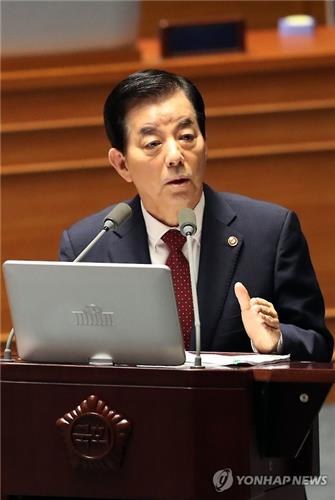- California Assembly OKs highest minimum wage in nation
- S. Korea unveils first graphic cigarette warnings
- US joins with South Korea, Japan in bid to deter North Korea
- LPGA golfer Chun In-gee finally back in action
- S. Korea won’t be top seed in final World Cup qualification round
- US men’s soccer misses 2nd straight Olympics
- US back on track in qualifying with 4-0 win over Guatemala
- High-intensity workout injuries spawn cottage industry
- CDC expands range of Zika mosquitoes into parts of Northeast
- Who knew? ‘The Walking Dead’ is helping families connect
Local THAAD will not be incorporated into wider U.S.-led MD system: defense chief
SEOUL, July 20 (Yonhap) — South Korea’s defense minister said Wednesday that the planned deployment of an advanced U.S. anti-missile system is for self-defense and will not be incorporated into the wider U.S. missile defense (MD) system.
Defense Minister Han Min-koo’s remarks made at the National Assembly policy review session come after speculations that the deployment of the Terminal High-Altitude Area Defense (THAAD) system in South Korea will invariably lead to the country becoming part of the Washington-led MD system which is seen by some as a move to isolate China.
Seoul announced on July 8, that it will allow a U.S. THAAD battery to be stationed in the country after months of deliberation.
The Seoul government has persistently said that it has no intention of joining the MD system and that it wants to build up its own “Korea Air and Missile Defense (KAMD)” system to deal with evolving North Korean missile and nuclear threats.

In this photo taken on July 20, 2016, Defense Minister Han Min-koo answers questions from lawmakers at the National Assembly on the planned THAAD deployment here.
“The government remains committed to not joining the MD shield, and this stance has not changed since the Kim Dae-jung administration,” the minister pointed out. The late president led South Korea until February 2003.
“In line with this policy, Seoul has stepped up efforts to build up KAMD,” he said. He made clear that the THAAD to be employed in South Korea will not be sharing information with the wider MD network.
The MD is a sensitive issue because it can alienate neighboring countries such as China and Russia that South Korea wants to maintain good relations with. China, in particular, is Seoul’s No. 1 trading partner and a key player in Seoul’s drive to get North Korea to give up its nuclear ambitions.
Seoul aims to finish the installation of its locally produced defense systems like its “kill chain” and KAMD by 2020. The kill chain aims to enhance Seoul’s capability to detect and destroy North Korea’s weapons of mass destruction.
As THAAD is an integral part of the U.S. MD system, China and Russia see it as a threat to their security interests if deployed in South Korea.
Han, meanwhile, commented on the effectiveness of the THAAD system and the level of protection it can offer the country by saying that having more layers of protection is always preferable to having fewer.
The policymaker said that South Korea, in particular, has little choice other than to build up its anti-missile capabilities.
“Deterring nuclear attacks with nuclear arms of our own is a way, but since the country has declared itself a non-nuclear power, we have limited options in choosing weapons for self-defense,” the policymaker argued. “Under these circumstances the deployment of a THAAD battery that can improve our missile interception capabilities is a significant step.” He then said among antimissile systems existing at present, THAAD is the most potent, so it is the best choice for the country.











